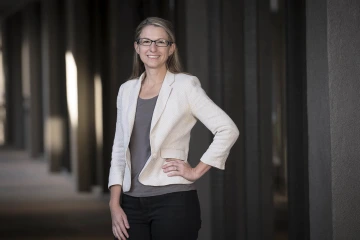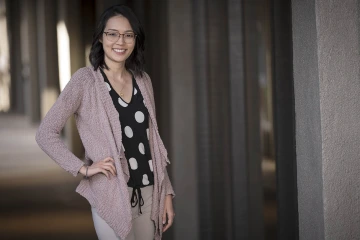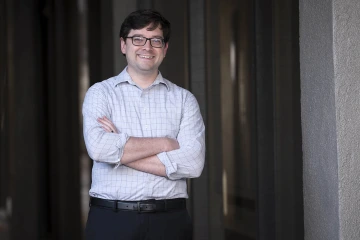HIV/AIDS Care Team, Training Program Pivot During Pandemic
Pandemic-related changes helped provide a continuum of care, while also reducing clinic “no-shows.”

(From right) Cesar Egurrola, lead clinical coordinator and case manager; Larry York, PharmD, BCIDP, BCPS, AAHIVP, clinical pharmacist, infectious diseases and HIV/AIDS; and Matthew Adams, DO, speak with a visitor at the Petersen Clinic.
Like heart disease and cancer, HIV and AIDS were treated as secondary public health concerns as the COVID-19 pandemic took hold around the world. The needs of patients were still there, of course, and the University of Arizona Health Sciences teams that specialize in HIV/AIDS adapted quickly to continue providing care and training.
The Petersen HIV Clinics, operated by the Division of Infectious Diseases in the University of Arizona College of Medicine – Tucson, initially scrambled to assure people concerned they were HIV positive – as well as others currently under treatment for HIV/AIDS – that they would continue to have preventive services and care available from one of the best HIV care teams in the country.

Alyssa Guido, MPH, program director for the Petersen clinics and PAETC Arizona, UArizona College of Medicine – Tucson, said partnering with community organizations along with the Arizona Telemedicine Program has helped the clinic continue to provide services to those who are HIV positive, have AIDS or think they might have been exposed.
Likewise, the Pacific AIDS Education and Training Center (PAETC) – Arizona, a unit of the California-based Pacific AETC operated in Arizona by the Infectious Diseases division, had to quickly adjust how it would continue fulfilling its mission of training clinical providers on HIV/AIDS care across the state.
Those care and training efforts have continued to grow, said Alyssa Guido, MPH, program director for the Petersen clinics and PAETC Arizona, including a new partnership with the Arizona Telemedicine Program to expand telehealth capabilities for care and training. They also include outreach with community partners such as the Pima County Health Department, Southern Arizona Center Against Sexual Assault (SACASA), Southern Arizona AIDS Foundation (SAAF) and Tucson Interfaith HIV/AIDS Network (TIHAN) to coordinate communications and find new ways to reach and serve patients, caregivers and other clients.
Engagement and adherence
Guido and colleagues Andrea Verdin, LMSW, senior program manager over the clinics’ day-to-day operations, medical case management and early intervention programs, College of Medicine – Tucson, and Connie Chan, PharmD, clinical operations director, head clinical pharmacist and team lead for the HIV Treatment Adherence Clinics, College of Medicine – Tucson, acknowledged that keeping people engaged and on their medications during the pandemic was a challenge.

Andrea Verdin, LMSW, is senior program manager for the clinics’ day-to-day operations, medical case management and early intervention programs at the Petersen HIV Clinics
Although most patients were wary of in-person visits because of COVID-19, some still preferred face-to-face visits.
“People were generally pretty split,” Dr. Chan said. “For some, it’s a technical challenge. For others, especially patients who live in Sierra Vista or Benson that are farther away, they would rather not have to drive the distance to Tucson.”
Virtual HIV/AIDS care training
“The beauty of the PAETC Arizona program is that we not only provide training, we also provide clinical consultation,” Guido said. “If providers have a question about a patient, they can speak with one of our HIV pharmacists or infectious diseases doctors and talk through care for that patient. Often, the primary care provider can continue to manage that patient with support from us here.”

Connie Chan, PharmD, is clinical operations director, head clinical pharmacist and team lead for the HIV Treatment Adherence Clinics, College of Medicine – Tucson.
Since virtual trainings are not limited by room size, more people can be trained, particularly those who live in hard-to-reach rural areas. Nine providers were trained in 2019-20 versus 17 in 2020-21’s virtual format, Guido said.
An annual one-day clinical update conference on HIV, sexually transmitted infections and TB also more than doubled attendance, from 82 in-person attendees in 2019 to 180 virtual attendees in 2021.
CARES Act and other funding
“The beauty of our program is that we not only provide training, we also provide clinical consultation.”Alyssa Guido, MPH
Guido noted the UArizona Petersen clinics and PAETC Arizona receive federal funds through the HRSA Ryan White HIV/AIDS Program. But early in the pandemic the local HIV/AIDS programs were awarded a $92,000 Coronavirus Aid, Relief, and Economic Security (CARES) Act grant. That allowed them to purchase cell phones for clinical coordinators, medical case managers and early intervention staff to contact patients about how to get lab work done, receive medications or complete clinical visits during the pandemic.
The CARES Act grant also allowed the HIV/AIDS team to provide financial assistance to patients, who might have found themselves suddenly without a paycheck and in financial distress due to the pandemic. That includes assistance for housing, utilities and food.
New infections and long-term survivors
Matt Adams, DO, an assistant professor of infectious diseases at the College of Medicine – Tucson, recently became principal investigator for the Ryan White program at the University of Arizona Health Sciences. Dr. Adams worries about people who were possibly exposed to HIV during the pandemic but who haven’t been tested yet. For those who become HIV positive, he underscores how much HIV/AIDs treatment has advanced in recent years.

Matthew Adams, DO, an assistant professor of infectious diseases at the College of Medicine – Tucson, recently became principal investigator for the Ryan White program at the University of Arizona Health Sciences.
“And then I have patients who are just in their 20s. They’re newly diagnosed, suffer from substance abuse, homelessness or other issues like poor finances. Those patients are just coming to grips with the diagnosis and trying to understand the weight of it, and how to best manage it, how they can live their lives with it.
“That’s the message we’re trying to convey, that you can live a full life. You can become a geriatric patient. This is the era of medicine that we live in, and that’s what I really enjoy about providing HIV care.

